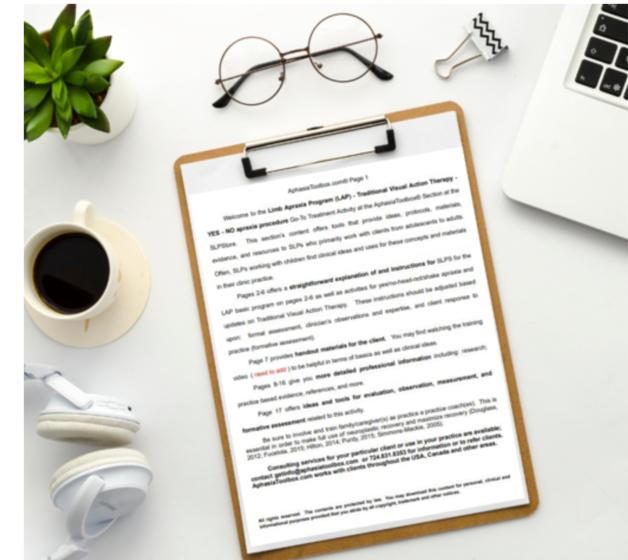
Acquired apraxia (AA) negatively impacts both the daily life and recovery of, not only stroke victims, but also others suffering from brain injury, and progressive neurological disorders. The jury is in - acquired apraxia is treatable. Visit www.everythingSLP.com for your treatment answers and tools.
“I am a speech pathologist; why should I address apraxia that affects the limbs?” That is a fair question. In addition to improving ADL and QOL, here are a some important reasons why your client with communication problems will benefit from addressing his/her underlying acquired apraxia:
1. You can help the client immediately improve functional communication for everyday needs. Resolving motor planning problems will reduce mental resources demands, increasing available mental resources for speech-language activities and everyday communication.
2. You can increase the chance that the client will use AAC devices and techniques. Improving the client’s volitional control of arm and hand can facilitate possible use of technology such as AAC device, keyboard, iPhone, keyboarding, and other devices.
3. Addressing AA will allow for a clearer differentiation between the effects of AA and phonological aphasia (PA) on speech production, enhancing the treatment program. PH aphasia is frequently misdiagnosed as AA.
4. A client with improved hand/arm control can better exploit some of the existing SLP EBP treatment programs such as PACE, VAT, etc.
5. Resolving motor planning problems will create greater opportunity to incorporate gestural communication into both pragmatic treatment activities and real-world communication.
6. A rising tide lifts all boats. Mindful therapy that improves deliberate control of fingers, hands and arm may well simultaneously stimulate neural reconnections that improve tongue, lip, jaw movements. A by product of improved motor planning and execution is improved connection between brain and limb which can be highlighted and exploited in brain and mouth-larynx treatment.
7. Improving hand and limb control can contribute to improved client ADL and safety given the non-compliance and poor recognition of safety situations associated with apraxia (Buchman, 2018). Since there is a lack of adequate techniques and tools available for the aphasia-apraxia clinician working to address anosognosia, the lack of client insight into impairments, the visual and physical nature of AA treatment may provide opportunities with this issue. Apraxia has real world consequences.
9. Use of gestures can anchor the canonical concept of subject-verb-object facilitating syntactic recovery by activating the multi-modal aspects of Broca’s area and anchoring the verb slot.
10. Gesturing as one speaks may improve later recall of that spoken information. Cook (2018) found that those who gesture while talking remember what they had said better than when they did not gesture.
These treatment activities can provide uniques opportunities to effectively address co-occurring cognitive impairments that impact speech and language recovery (Helm, Huegentein . As note in #9 above, gesture may improve memory. Trofatter (2015) reported that gesture may assist problem solving as. “ ...gesture grounds thought in action…” and Cherdieu (2017) observed facilitation of language and conceptual learning with gestures. This product is part of the PickUp Doable series at EverythingSLP.
